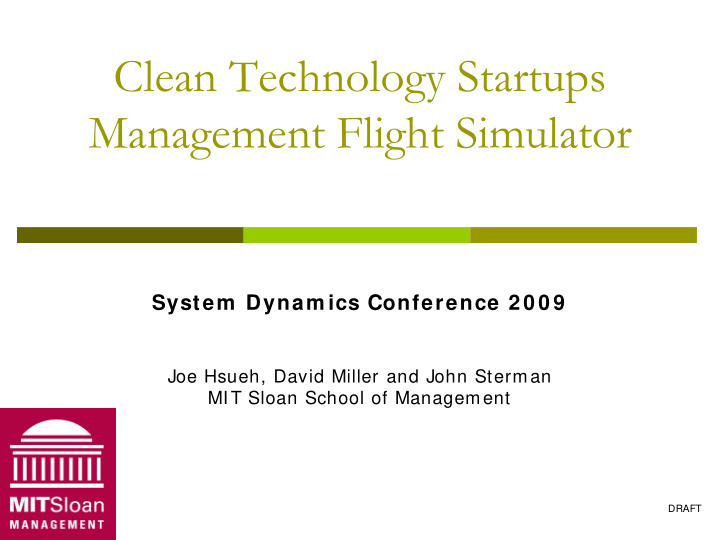



Clean Technology Startups Management Flight Simulator System Dynam ics Conference 2 0 0 9 Joe Hsueh, David Miller and John Sterman MIT Sloan School of Management DRAFT COPY DRAFT
Research Question/Teaching Purpose � What are the dynamics of green tech startups and how can their odds of success be improved? � Long sales cycles � Engineering vs. sales force focus � Valley of death � How can different ownership structures affect employee behavior and firm performance? � Traditional external funding (e.g. VC financing) � Employee ownership (partial or full) � More generally, under what conditions do various employee ownership structures lead to superior financial performance? DRAFT COPY
Selected Determinants of Firm Performance Competitor Product Action Development Market Conditions Ownership Structure (Hard) Learning Curve Employee Firm Productivity Performance Marketing + + HR Practice + (Soft) Other Pricing Factors Gov't Policy DRAFT COPY
Selected Reinforcing Loops of Em ployee Ow nership Structure Employee Ownership Red: decision variables Firm Market Structure Blue: growth drivers + Value Green: employee ownership drivers Profit R8 + R9 Marketing + + + Budget Compensation Hiring Budget Psych Psychological Financial Package for Sales and Reward Reward Reward + Learning Engineers + Curve Revenue + R2 WOM + + + + R11 Recruitment and Learning Curve R3 R4 Retention We own this! Sales R10 R5 + + WOM Brand Equity + - R1 + We will be rich! Product - Product Awareness + Unit Cost Awareness Employee + Scale Economy + Product + Sales and Experience Attractiveness + - + Engineering Employee + + + Price Effort Productivity R6 R12 + Features + Experience Brand + Features Equity R7 Customer Customer Support Support + DRAFT COPY Note: these are selected reinforcing loops of the effects of employee ownership structure. Balancing loops that limit the effects are not shown.
Starting point � David Miller’s (2007) PhD thesis on the dynamics of clean technology startup companies. � Needed much more structure � Financial � Competition from other startups � Ownership structure � others DRAFT COPY
What we have done… Expanded the prospect chain to track the flow of potential � customers to potential prospects to prospects to hot prospects to adopter. Indexed firms to allow m ultiple com petitors . Currently three: � incumbent, startup1 and startup 2. Added firm attractiveness drivers to determine market share � with multiple competitors. Expanded hum an resource sector to include rookie vs. � experienced employees, and their respective experience and productivity. Indexed employees to track sales force and engineers . � Added and integrated the financial sector from Oliva, Sterman � and Giese (2003). It includes shares outstanding, stock options, financial market, balance sheet and income statement. Modified job attractiveness drivers to capture impact of financial � rewards (including stock options) on employee retention. Added operations and system costs of operating the new � product And more… � DRAFT COPY
Model Sectors � Prospect Chain � Five stages from potential prospects to adopters � Product Development � Human Resource � Engineers vs. Sales force � Employee experience � Employee productivity and learning � Employee ownership structure (to be expanded) � Financial Sector � Shares outstanding � Stock options � Financial market � Balance sheet � Income statement � Competitors � Incumbent, Startup 1, Startup 2 DRAFT COPY
Management Flight Simulator: Case Scenario You are the CEO of a green technology startup company facing � with competition from the existing incumbent and another startup. You have developed a superb technology that may cost more than � the existing technology up front, but saves energy costs in the long run. You need to promote your product to customers through your � sales force, while keep up product development by hiring, motivating and retaining engineers. You face resistance from potential clients who are unfamiliar with � such technology You face competition from other startups and from the incumbent � utility/ energy provider, which may enter your market You have initial funding of $x million to grow the company � successfully from startup to success. To succeed, you need to make the following decisions… � DRAFT COPY
Management Flight Simulator: Decision Variables � Employee hiring: headcount growth rate � Employee allocation: engineers vs. sales � Financing options: VC Financing, Employee Ownership � Employee ownership structure: ESOP, options, stock grants? � Tradeoff between transparency, usability and model complexity/ realism, number of decisions people can make DRAFT COPY
Management Flight Simulator: Game Interface � Next few slides are screen shots of the beta version of the Clean Technology Startup Management Flight Simulator for illustration purpose. � The first is the decision making screen followed by a reporting screen. � We aim to use it for teaching at the Sustainability Lab (S-Lab) course at MIT Sloan School of Management. DRAFT COPY
DRAFT COPY
DRAFT COPY
DRAFT COPY
Recommend
More recommend